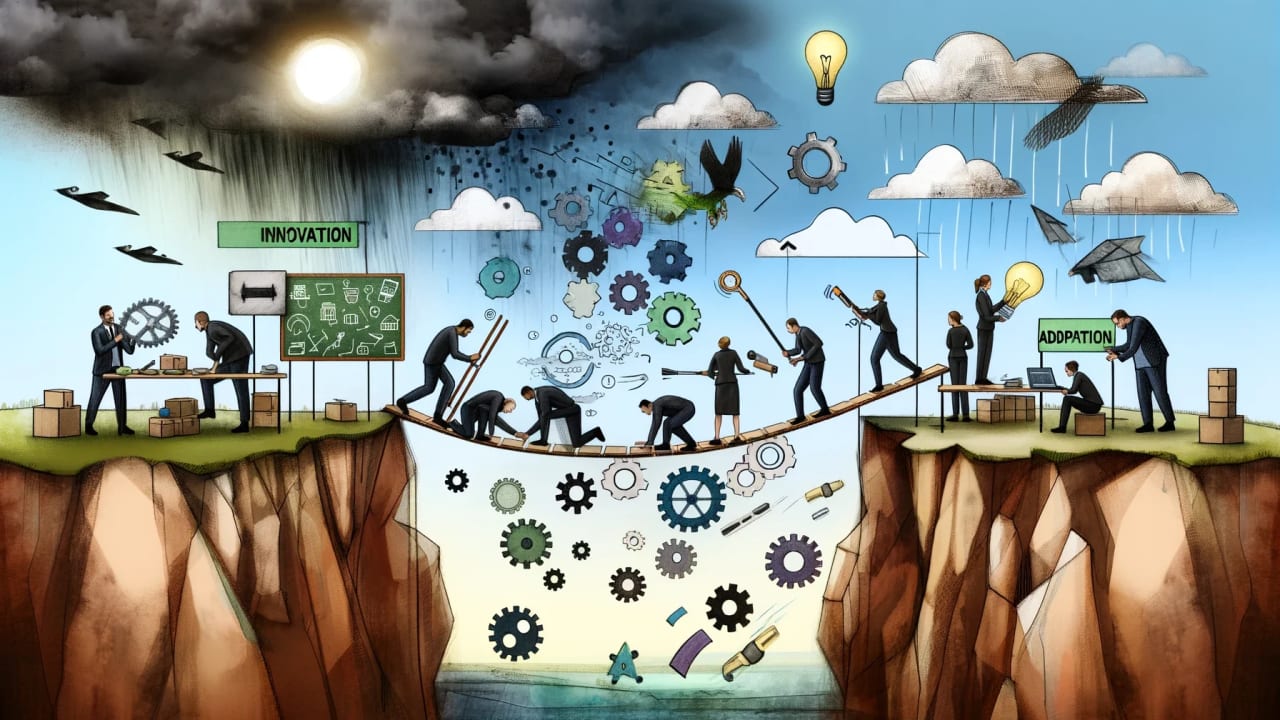Mastering Ambiguity: Thriving in Early-Stage Companies
Reading time: 9min
Successfully navigating early-stage companies' unpredictable waters requires more than technical skills and a clear job description. It demands an ability to dive headfirst into the unknown, armed with nothing but a willingness to learn and adapt. This article explores the essence of thriving in ambiguous environments, offering insights from a decade of firsthand experiences and successes.

The Unique Challenge of Early-Stage Companies
Early-stage ventures often mean stepping into the unknown, whether due to new technology, vague requirements, or undefined tasks. Embracing these challenges unlocks growth and opportunities for innovation. Simultaneously innovating and adapting in rapidly changing circumstances allows individuals to turn obstacles into stepping stones for success, creating a dynamic environment ripe for growth and learning.
Thriving in Ambiguity
Ambiguity often receives negative connotations, yet it can fuel creativity and innovation. By embracing this mindset, we transform potential threats into opportunities, highlighting the significance of resilience and adaptability. Success stories exemplify the benefits of welcoming uncertainty, such as mastering a new ecosystem to incorporate a point-of-sale system or investigating to uncover the limitations of new devices. These actions result in concrete outcomes and personal development. Ultimately, this approach improves our problem-solving abilities and creativity.
The Downside of Ambiguity
It is important to understand that not all uncertainty is helpful. It is necessary to differentiate between constructive ambiguity and destructive chaos. Indications of dysfunction, such as continuous miscommunication or a lack of guidance, necessitate a more organized approach. To balance flexibility and structure, it is essential to communicate clearly and establish precise goals. This fosters an environment in which creativity can thrive without descending into chaos.
The Art of Self-Direction in Ambiguous Environments

When there are no clear instructions, developing an internal compass is essential. This means improving your decision-making abilities, being flexible to make changes, and gaining knowledge from the results. To make effective decisions in unpredictable situations, you can divide complex goals into smaller tasks, find a mentor for guidance, and align your actions with the organization's mission. By following these strategies, you can confidently navigate ambiguity.
The Power of Flexibility and Adaptation
Early-stage companies experience constant changes, which can benefit those who embrace them. This approach fosters continuous learning and facilitates quick adaptation to new information or market demands. Developing a growth mindset and the ability to learn new skills quickly in challenging environments is crucial. This can turn difficulties into opportunities for expanding knowledge and skills.
From Chaos to Clarity: Defining Objectives
When there is a lot of uncertainty, setting clear and flexible goals can be a challenge, but it is essential to do so. Setting well-defined milestones is crucial because it provides direction and allows for changes that are bound to happen. Leadership has a critical role to play in guiding teams through ambiguous situations. Influential leaders can instill confidence in their teams and foster a culture of experimentation and learning.
Case Study: Point of Sale Integration
This case study demonstrates how resilience, creativity, and teamwork can overcome challenges when faced with unclear requirements and prior experience. The iterative process, customer feedback, and supportive team culture were crucial in overcoming obstacles.
The experience of creating a point of sale (POS) integration for a new product became an important moment of growth and learning for us. We faced the challenging task of venturing into an entirely unfamiliar ecosystem. Our team embarked on a journey that tested our limits of adaptation and innovation. We needed solid requirements and to gain experience within POS systems. We found ourselves at the intersection of potential and the unknown. This was not merely a technical assignment but a quest to discover a solution to a problem we had yet to define.
The thrill of this experience was rooted in its unpredictability. We needed to develop an integration using an unfamiliar programming language while exploring various possibilities for our product and primary audience. This situation highlights the significance of adaptability and embracing change as a constant. Change is not a startup hindrance but a path towards innovation and progress. By acknowledging this truth as an essential part of our journey, we transformed it into a strategic advantage, creating an environment ideal for continuous learning and agile pivoting in response to new information or market demands.
Embracing Change as a Constant
The thrill of my experience stemmed from its unpredictability, requiring me to develop an integration using an unfamiliar programming language and explore various possibilities for our product and primary audience. This situation underscored the importance of adaptability and embracing change as a constant, revealing that change is not a hindrance for startups but a pathway to innovation and progress. By viewing change as an essential and inevitable aspect of our journey, I turned it into a strategic advantage, fostering an environment conducive to continuous learning and agile pivoting in response to new information or market demands. This mindset not only encourages adaptability but also positions employees and leaders to leverage the dynamic nature of their environment for sustainable innovation and growth.
Learning on the Go: Skills for the Unknown
During our journey, we realized the importance of adaptability and willingness to learn new skills in uncertain environments. We focused on developing these essential abilities and emphasized the value of having a growth mindset. Instead of seeing challenges as obstacles, we viewed them as opportunities to expand our skills and knowledge. We navigated through mastering new technologies and adapting to different roles within the company. The ability to learn on the go emerged as a key factor in determining success in the ever-changing landscape of early-stage companies.
This part of our story shows us that even though navigating through unfamiliar territories can be difficult, it is a valuable experience that can help us develop resilience, creativity, and innovation. It has taught us that creating something new is not just about reaching a destination, but about the skills we acquire, the lessons we learn, and the mindset we develop. By being open-minded, flexible, and willing to learn, we could turn our uncertainties into our greatest strengths, which helped us move forward even more rapidly.
Exploring New Frontiers: iPad Infinite Canvas
In 2011, an Atlanta-based agency I was working with started a project with The Home Depot to create a layout using an infinite canvas on the first-generation iPad that had just been released. We aimed to revolutionize the way interactive articles and how-to guides were presented. At that time, most experiences were linear, magazine-like, requiring hefty download sizes that were too large for mobile connections. Our objective was to introduce a dynamic and interactive platform that would be user-friendly. During the early stages, the UX lead and I worked closely together, engaging in an iterative process of exploration and feedback that helped us push the limits of the iPad's capabilities. This journey was not just about technical experimentation; we also integrated user insights into the development process, making it a user-centered endeavor.
Breaking Boundaries with Innovation
While developing an infinite canvas on the iPad, we faced a major challenge that prompted us to seek innovative solutions and question the existing limitations of digital publishing. Our journey reinforced the importance of challenging the status quo and the significance of user feedback in shaping technological advancements. By refusing to accept the limitations of current digital experiences, our team ventured into uncharted territory, demonstrating remarkable achievements possible when we embrace uncertainty and foster innovation. The exceptional performance of the application led to it receiving the prestigious "iPad App of the Year" award, a true testament to its outstanding success, which I attribute largely to the team's mindset in approaching the project.
Integrating Feedback into Design
The infinite canvas project emphasized incorporating user feedback throughout the design and development process. This approach allowed us to improve the product continuously based on real-world usage and highlighted the importance of an iterative design philosophy that prioritizes user needs and experiences. The success of the Infinite Canvas project is a testament to the value of a responsive and flexible design philosophy informed by user feedback. As we progressed, insights from our audience played a pivotal role in refining the product, which ultimately exceeded user expectations. This showcases the transformative potential of user-informed design.
When adopting new technology, it is important to consider both the risks and opportunities. This section discusses strategies for mitigating risks and navigating early technology adoption, including research, pilot testing, and incremental implementation. Ultimately, the success of new technology is determined by user perception.
Building a Hipster Monorepo
before it was cool
In 2017, I was appointed to lead a UX engineering team at a company. We undertook an ambitious project to centralize our front-end ecosystem into a monorepo. This was a year before the debut of NX or Lerna, two pivotal tools in monorepo management. Our task was to consolidate front-end design systems, token generation, data services, shared UI components, and company-wide linting and testing configurations. During the first year, we focused on fine-tuning our continuous integration (CI) and deployment (CD) processes while building out the system's base. Since our team was relatively small, it was crucial to streamline our workflows to avoid becoming a bottleneck in the development process.
Pioneering in Process Optimization
Creating a unified codebase for all front-end systems was a new endeavor for us, especially without the luxury of modern monorepo tools. In this journey, we faced technical and organizational hurdles that we had to overcome with inventive approaches. Our story exemplifies the forward-thinking and determination necessary to refine development processes and establish new benchmarks in the industry. It sheds light on the vision that drove the consolidation of disparate codebases and showcases the importance of overcoming challenges to achieve success.
The Impact of Anticipating Future Needs
The success of our monorepo project was mainly due to our team's forward-thinking approach. This approach allowed us to anticipate and adapt to future technological trends and requirements. We adopted a solution that met our immediate needs and was scalable and adaptable, placing us at the forefront of our organization’s needs. This highlights the strategic benefits of such foresight, demonstrating how proactive planning and a commitment to creating a flexible and unified development environment can significantly improve process efficiency and productivity.
Ironically, if I had known that the release of NX and Lerna - two of the best tools for managing monorepos - was less than a year away, we might have waited for them instead of using a manual process. However, our efforts to manually streamline our CI/CD process eventually paid off. Our engineers now only needed to build the changed projects, which reduced CI times, and we established a commit structure that facilitated automated semantic versioning (semver) releases for over 50 packages. This infrastructure allowed downstream consumers to upgrade safely, demonstrating our ability to innovate and adapt in a constantly evolving technological landscape.

Embracing Ambiguity: A Decade of Success for Founding Engineers
Success isn't a straight path but rather a journey through the unknown. Embracing uncertainty is the key to growth, innovation, and transformation. Challenges can become achievement and personal development opportunities when met with resilience, creativity, and adaptability. We can create an innovation ecosystem by approaching the unknown with an open heart and a growth mindset. Let's embrace ambiguity as a mindset that transforms challenges into opportunities for growth and innovation. Here's to the next chapter of innovation, learning, and success.